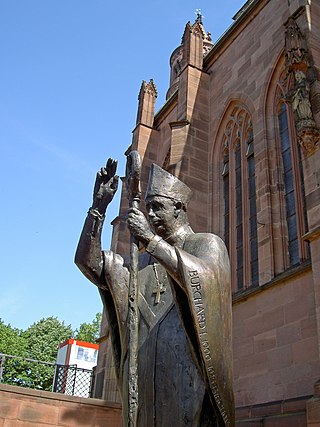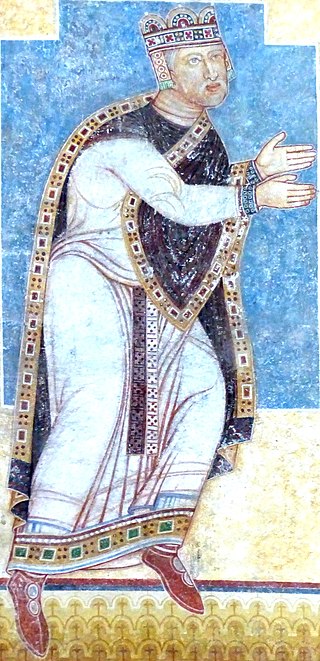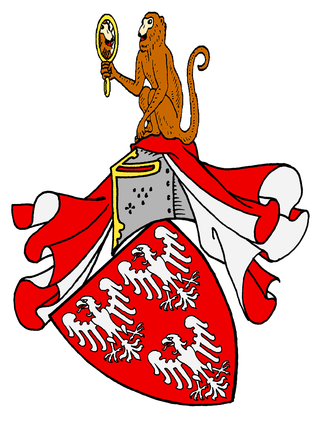Life

Conrad of Dahn, brother of the castellan, Frederick I of Dahn, was the cathedral canon in Worms, curator (Domkustos) of St. Cyriakus in Worms-Neuhausen, and provost of the chu
Conrad IV of Tann (German : Konrad IV. von Tann), also "of Thann" or "of Dahn", (died 1236) was the 48th Bishop of Speyer, holding office from 1233 to 1236.
Conrad came from the von Dahn family who, as episcopal ministeriales, owned estates in the southern Palatinate. The three castles of the Dahn as well as Neudahn Castle were initially all owned by the family.

Conrad of Dahn, brother of the castellan, Frederick I of Dahn, was the cathedral canon in Worms, curator (Domkustos) of St. Cyriakus in Worms-Neuhausen, and provost of the chu

Burchard of Worms was the bishop of the Imperial City of Worms, in the Holy Roman Empire. He was the author of a canon law collection of twenty books known as the Decretum, Decretum Burchardi, or Decretorum libri viginti.
Otto II, called the Illustrious, was the Duke of Bavaria from 1231 and Count Palatine of the Rhine from 1214. He was the son of Louis I and Ludmilla of Bohemia and a member of the Wittelsbach dynasty.

Dahn is a municipality in the Südwestpfalz district, in Rhineland-Palatinate, Germany. It is situated in the Palatinate Forest, approximately 15 km southeast of Pirmasens, and 25 km west of Landau. It is part of the Verbandsgemeinde of Dahner Felsenland.

Baldwin of Luxembourg was the Archbishop- Elector of Trier and Archchancellor of Burgundy from 1307 to his death. From 1328 to 1336, he was the diocesan administrator of the archdiocese of Mainz and from 1331 to 1337 of those of Worms and Speyer. He was one of the most important German prelates of his age.

Gisela of Swabia, was queen of Germany from 1024 to 1039 and empress of the Holy Roman Empire from 1027 to 1039 by her third marriage with Emperor Conrad II. She was the mother of Emperor Henry III. She was regent of Swabia for her minor son Duke Ernest II of Swabia in 1015, although it seems at that time her husband Conrad was the one who held the reins of government, leading to the enmity between stepfather and stepson.

Johannes von Geissel was a German Catholic Archbishop of Cologne and Cardinal from the Electorate of the Palatinate.

Rhenish Franconia or Western Franconia denotes the western half of the central German stem duchy of Franconia in the 10th and 11th century, with its residence at the city of Worms. The territory located on the banks of Rhine river roughly corresponded with the present-day state of Hesse and the adjacent Palatinate region in the south.

Altdahn Castle is a castle ruin in the Palatinate Forest, the German part of the Wasgau region. It is located near the town of Dahn in Rhineland-Palatinate, Germany. It stands 337 metres (1,106 ft) above sea level (NN).
Rupert I of Laurenburg, German: Ruprecht I. von Laurenburg, was count of Laurenburg and one of the ancestors of the House of Nassau.
Valdemar Knudsen was a Danish clergyman and statesman. Valdemar was Bishop of Schleswig from 1188 to 1208, officiated as Steward of the Duchy of Schleswig between 1184 and 1187, and served as Prince-Archbishop of Bremen from 1192 to 1194 and again between 1206 and 1217. He held the latter office on the grounds of the archdiocesan capitular election as archbishop elect and of the royal investiture with the princely regalia, but lacked the papal confirmation.

The history of the Jews in Speyer reaches back over 1,000 years. In the Middle Ages, the city of Speyer, Germany, was home to one of the most significant Jewish communities in the Holy Roman Empire. Its significance is attested to by the frequency of the Ashkenazi Jewish surname Shapiro/Shapira and its variants Szpira/Spiro/Speyer. After many ups and downs throughout history, the community was totally wiped out in 1940 during the Holocaust. With the fall of the Iron Curtain in 1989 Jews again settled in Speyer and a first assembly took place in 1996.

Henry V was King of Germany and Holy Roman Emperor, as the fourth and last ruler of the Salian dynasty. He was made co-ruler by his father, Henry IV, in 1098.

The Eisbach, locally known as die Eis, is a 38-kilometre (24 mi) long river and left or western tributary of the Rhine in the northeastern Palatinate and southeastern Rhenish Hesse, in the German state of Rhineland-Palatinate.
Ulrich IV, Lord of Hanau (1330/40–1380) was Lord of Hanau from 1369 or 1370 until his death. Based on the estimated year his parents married, he is assumed to have been born between 1330 and 1340. He was the son of Ulrich III of Hanau and Adelaide of Nassau.

Philip I of Rosenberg was Prince-Bishop of Speyer from 1504 until his death.

Grafendahn Castle lies in the southern Palatine Forest, the German part of the Wasgau region, just under 1 kilometre east of the small town of Dahn in the state of Rhineland-Palatinate.

Tanstein Castle is the ruin of a rock castle in the southern Palatine Forest, the German part of the Wasgau region. It lies just under a kilometre east of the small town of Dahn in the state of Rhineland-Palatinate.

The rock castle of Neudahn, in the southwestern Palatine Forest in the German state of Rhineland-Palatinate, is located at the northern end of an elongated ridge near the town of Dahn. The heart of the castle is situated on one of the sandstone rock outcrops that are typical of the Dahner Felsenland region.

Dahn, also Tan, Tann or Thann, is the surname of a noble family from the Palatinate region of Germany.
Rüdiger Huzmann was a German religious leader who served as the Roman Catholic Bishop of Speyer from 1075 to his death. He was born into an old Speyer family with Salian connections and before c. 1065 became a canon at Speyer Cathedral and head of the Speyer cathedral school.